Pork Adobo is made with succulent pork belly braised in vinegar, soy sauce, garlic, and onions. A delicious balance of salty and savory, this hearty stew is the Philippines' national dish for a good reason!
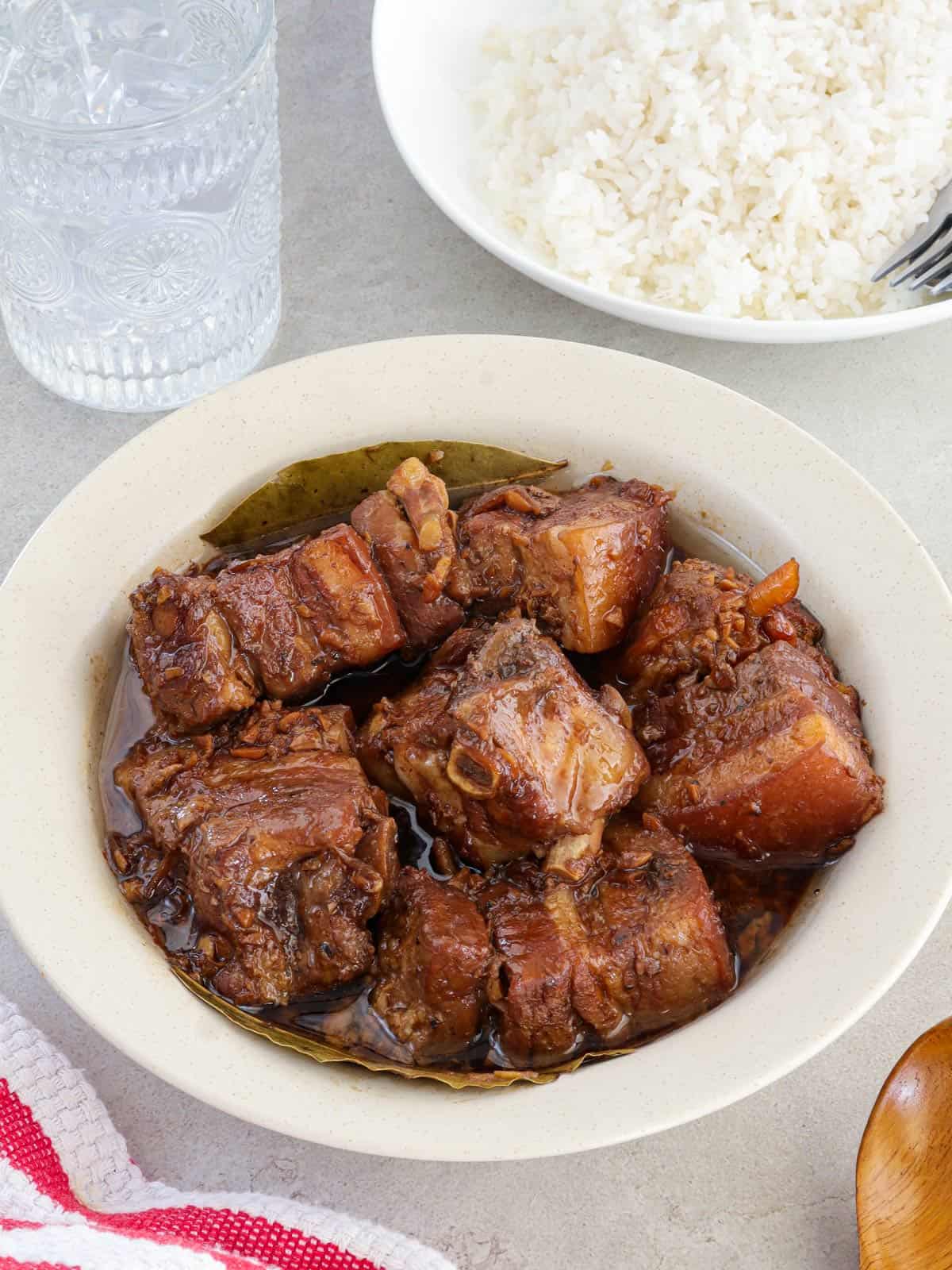
The Filipino adobo is a cooking process or technique in which meat, seafood, or indigenous vegetables are braised in a mixture of vinegar and aromatics such as garlic, onions, peppercorns, and bay leaves.
The many ways adobo is prepared are as diverse as the islands and dialects in the Philippines. Adobong pula with atsuete, Adobo sa gata, and Pineapple Pork Adobo are just a few versions of this classic Filipino national dish.
Some like the hearty stew with more sauce, while others prefer it simmered dry. Others like it slightly tangy, while some prefer it on the sweet side. This recipe is how I like mine, with beautifully seared pork and a rich and thick sauce to spoon over mounds of rice.
More adobo recipes to try
Ingredient notes
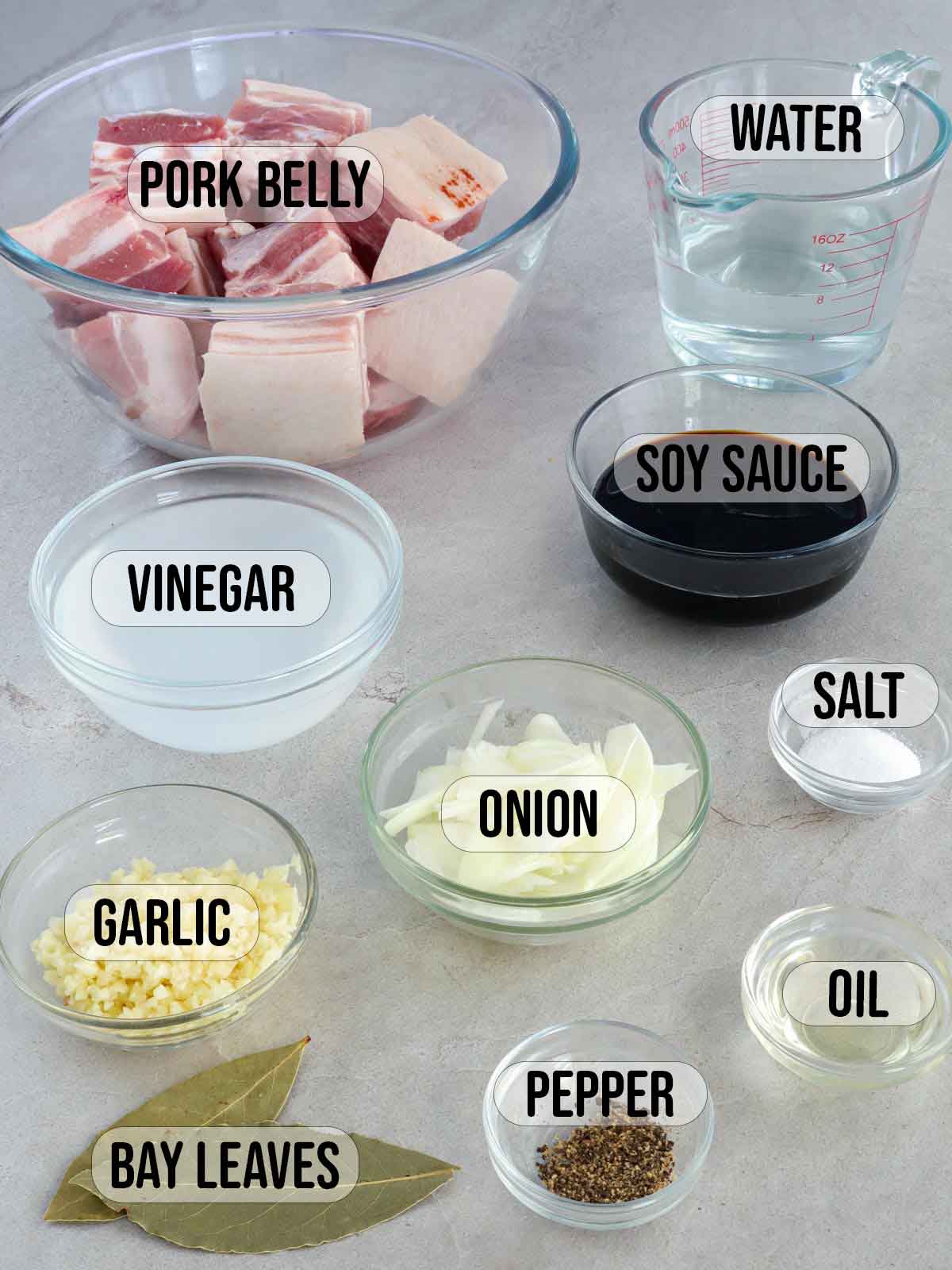
- Pork- I prefer to use pork belly in my adobo because I like its melt-in-your-mouth tenderness, but you can substitute pork shoulder, which, although a leaner cut, has enough ribbons of fat to bring equally delicious results. Other cuts, such as pork chops, legs, hocks, and ribs, are also good options for slow cooking.
- Oil- for sauteing and browning
- Sauce- a classic combination of tangy vinegar and savory soy sauce; water for tenderizing the meat.
- Aromatics- garlic, onion, bay leaves, and peppercorns enhance flavor.
- Seasonings- adjust taste with salt and pepper
Pork Adobo cooking steps
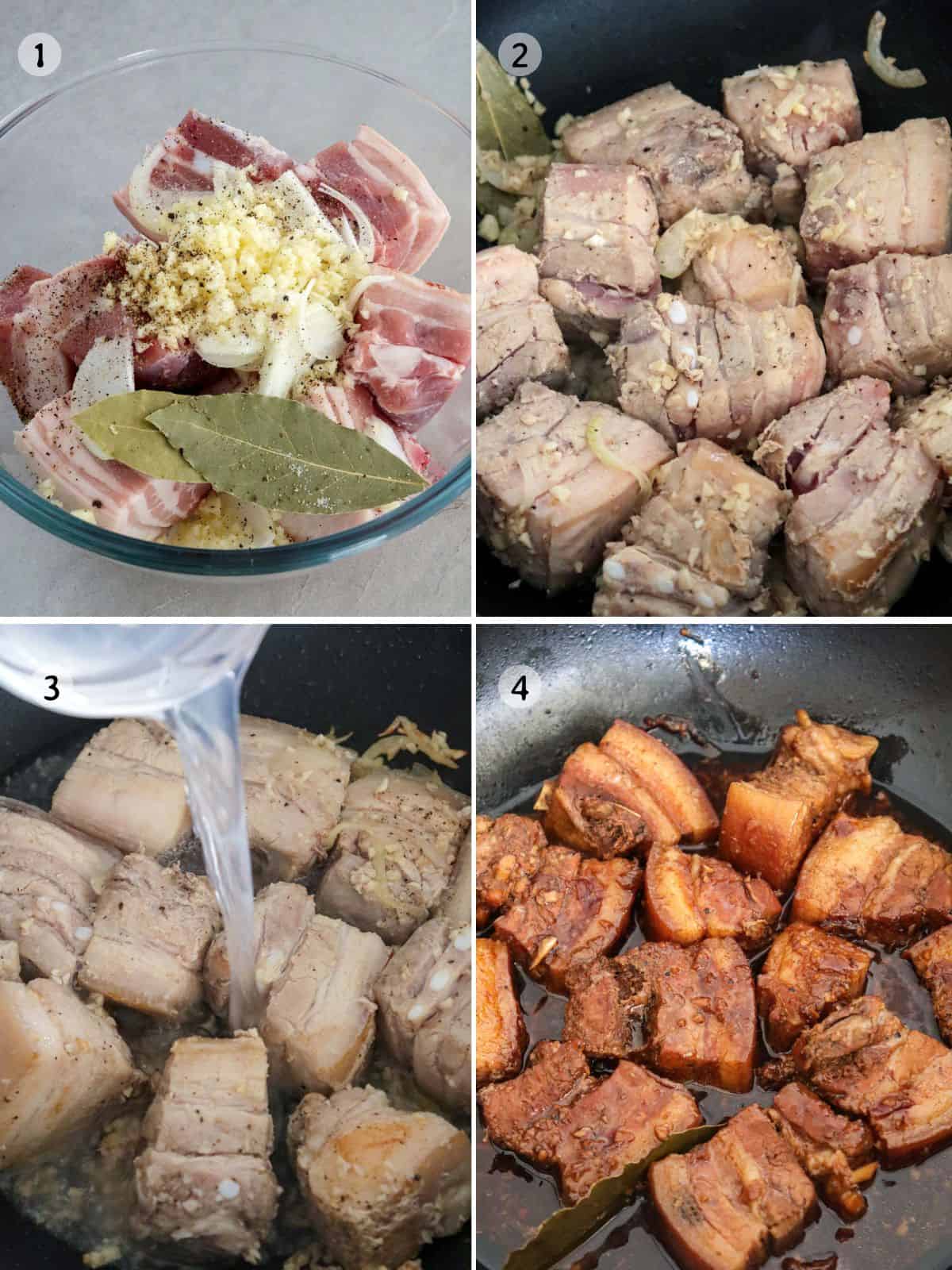
- Marinate- Cut the meat into uniform pieces to ensure even cooking. Combine with onions, garlic, bay leaves, salt, and pepper in a bowl. Marinate in the refrigerator for about 30 minutes.
- Brown the pork - Heat oil in a wide, heavy-bottomed skillet over medium heat. Add the meat mixture and cook, turning occasionally, until the pork is lightly browned. Do not overcrowd the pan when browning the pork so it gets a good sear and does not steam. Use a wide pan or cook in batches if necessary. Properly searing the meat before adding the braising liquid is an important step, as it gives the dish a delicious color and incredible depth of flavor.
- Add vinegar and allow it to boil, uncovered, without stirring to cook off the strong acid taste.
- Cook- Add soy sauce and water and stir to combine. Bring to a boil. Lower the heat, cover, and simmer until the meat is fork-tender and the sauce is reduced. Season with salt and pepper to taste.
Cooking tips
- Potatoes and hard-boiled eggs are a delicious way to extend servings. To help the potatoes from falling apart, pan-fry the cut potatoes first before adding them to the stew.
- If you want to season the dish with more salt than the recipe calls for, I suggest adding it during the last few minutes of cooking to gauge taste correctly. The flavor of the dish will concentrate as the sauce reduces.
Serving suggestions
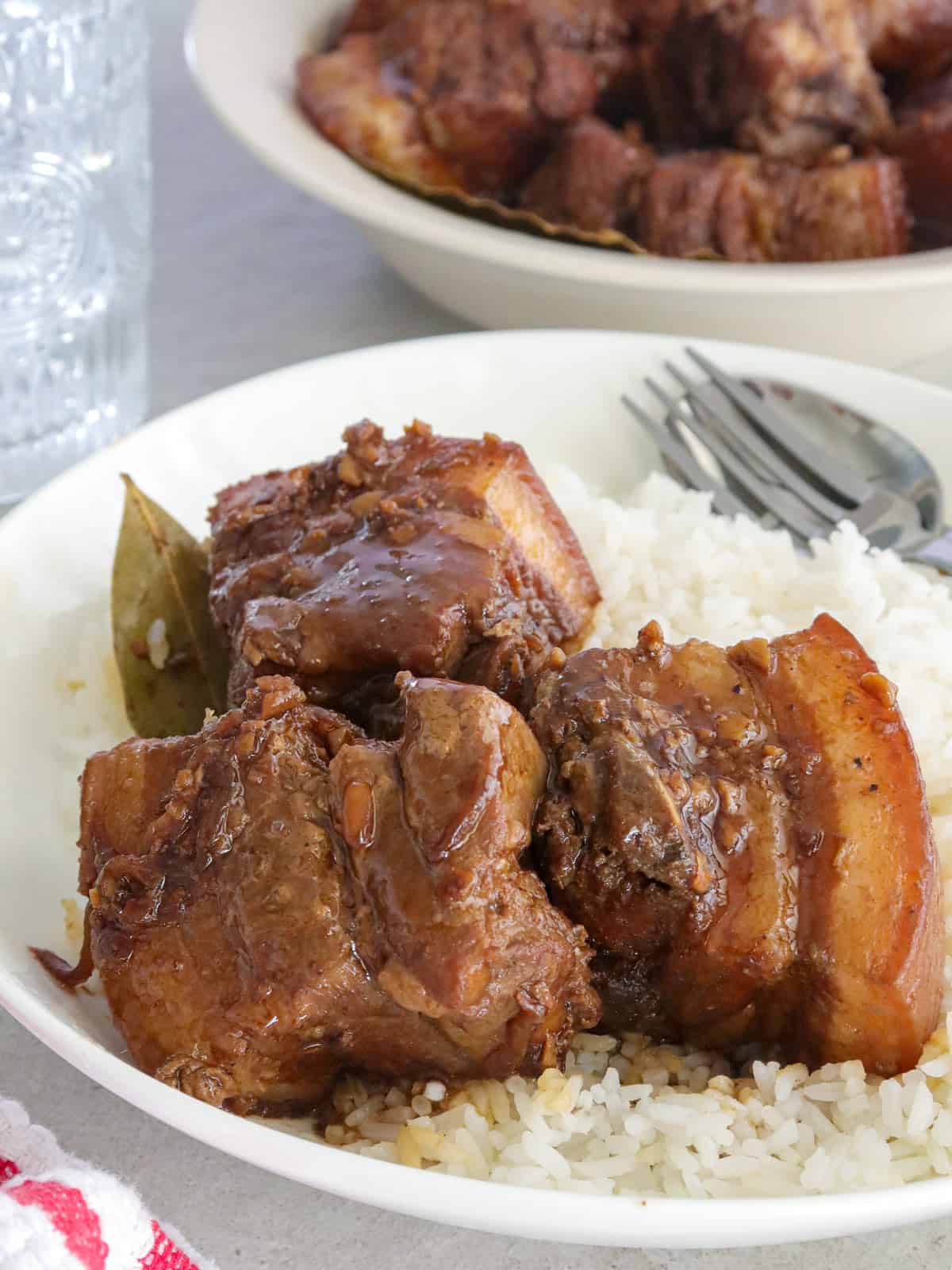
- Adobong baboy is best enjoyed with piping hot steamed rice for lunch or dinner. It's common to find it on breakfast menus, such as an adosilog meal (adobo, garlic fried rice, and fried egg).
- While it is mainly served as a viand, adobo meat is also used as a filling for bread, such as siopao or pandesal.
Storing leftovers
The adobo cooking process was initially a way to preserve food. Pre-colonial Filipinos prepared meat and seafood in vinegar and salt to prolong shelf life. It's a great make-ahead dish that tastes better after a day or two when the flavors have melded.
- Cool completely before transferring to a container with a tight-fitting lid. Refrigerate for up to 3 days or freeze for up to 2 months.
- Reheat in a wide pan over low heat to an internal temperature of 165 F or in the microwave at 2 to 3-minute intervals until completely heated.
- Leftovers can also be turned into delicious fried rice. Shred the cooked meat and toss with day-old steamed rice in a hot pan along with a few tablespoons of the sauce.
Ingredients
- 2 pounds pork belly, cut into 2-inch cubes
- 1 onion, peeled and sliced thinly
- 1 head garlic, peeled and minced
- 2 bay leaves
- 1 teaspoon salt
- ½ teaspoon pepper
- 1 tablespoon oil
- 1 cup vinegar
- ½ cup soy sauce
- 1 cup water
Instructions
- In a bowl, combine pork, onions, garlic, bay leaves, salt, and pepper. Place in the refrigerator and marinate for about 30 minutes.
- In a wide, heavy-bottomed skillet over medium heat, heat oil. Add meat mixture and cook, turning occasionally, until pork is lightly browned.
- Add vinegar and allow to boil, uncovered and without stirring, for about 3 to 5 minutes.
- Add soy sauce and water and stir to combine. Allow to a boil for another 3 to 5 minutes.
- Lower heat, cover, and simmer for about 40 to 50 minutes or until meat is fork-tender and sauce is reduced.
- Season with salt and pepper to taste. Serve hot.
Notes
- Cook off the strong vinegar flavor by allowing it to boil uncovered and without stirring for a good few minutes before adding the soy sauce and water.
- If you want to season the dish with more salt than called for in the recipe, I suggest adding it during the last few minutes of cooking to correctly gauge taste. The flavor of the dish will concentrate as the sauce reduces.
Nutrition Information
“This website provides approximate nutrition information for convenience and as a courtesy only. Nutrition data is gathered primarily from the USDA Food Composition Database, whenever available, or otherwise other online calculators.”

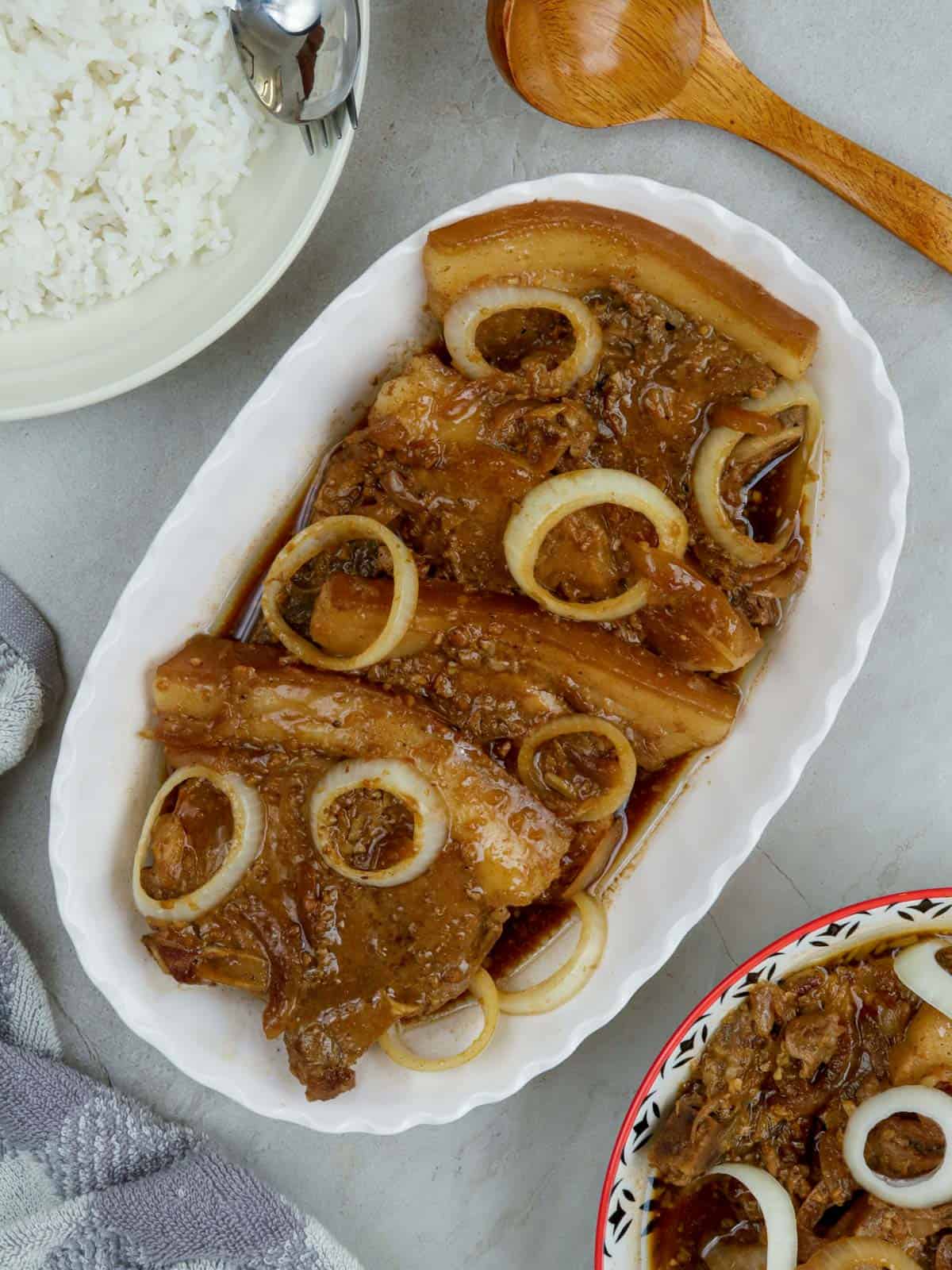
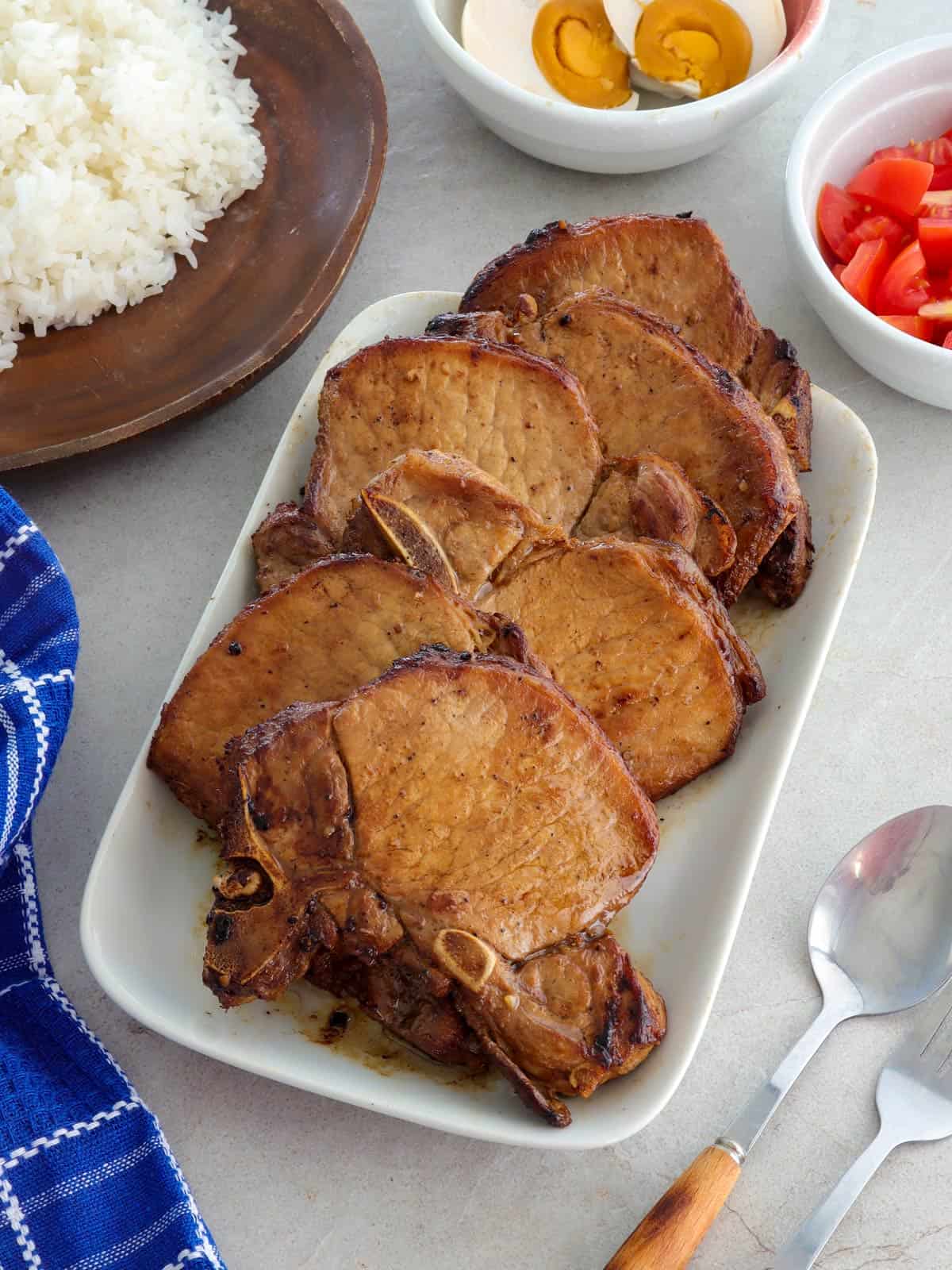
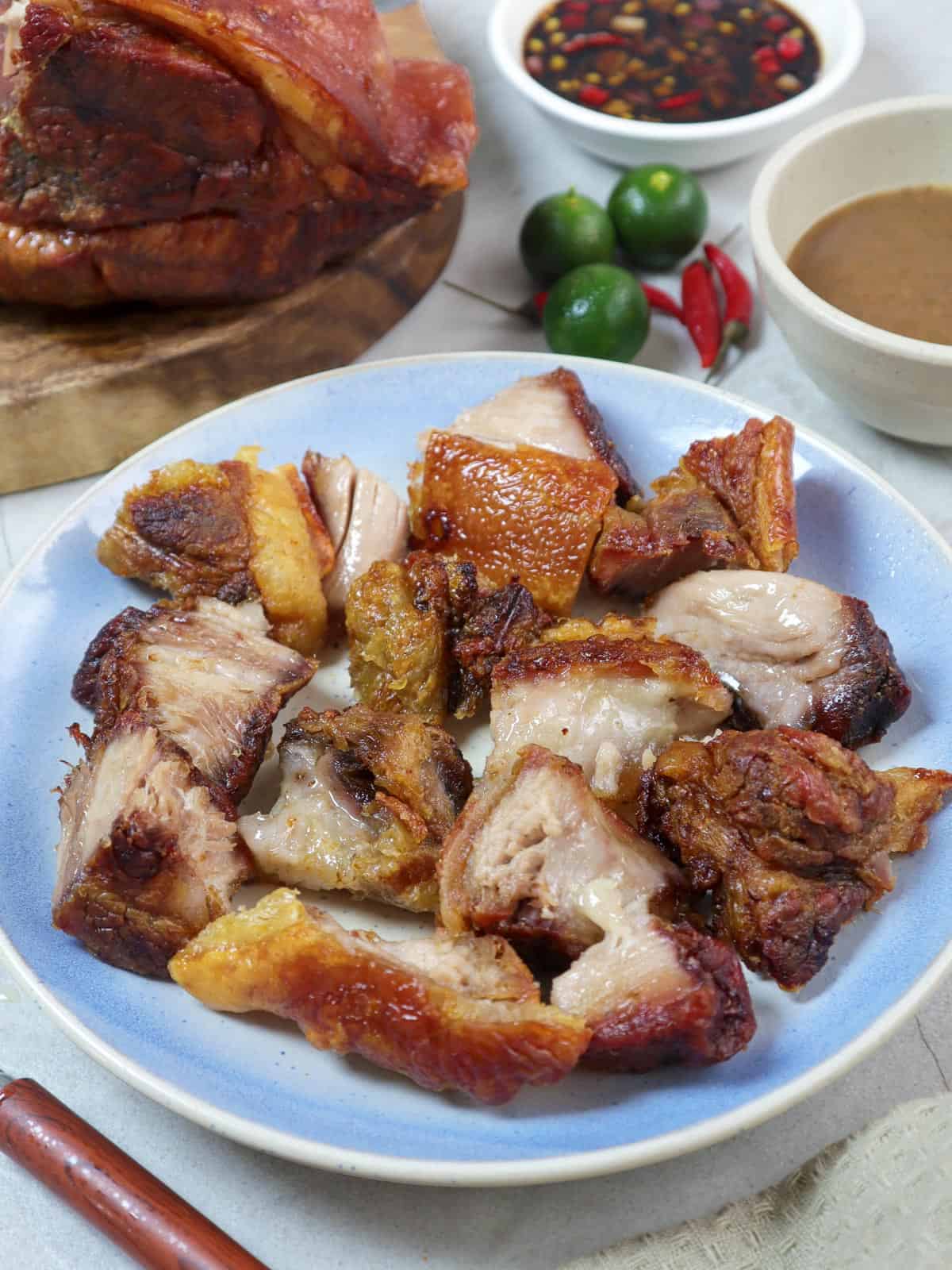
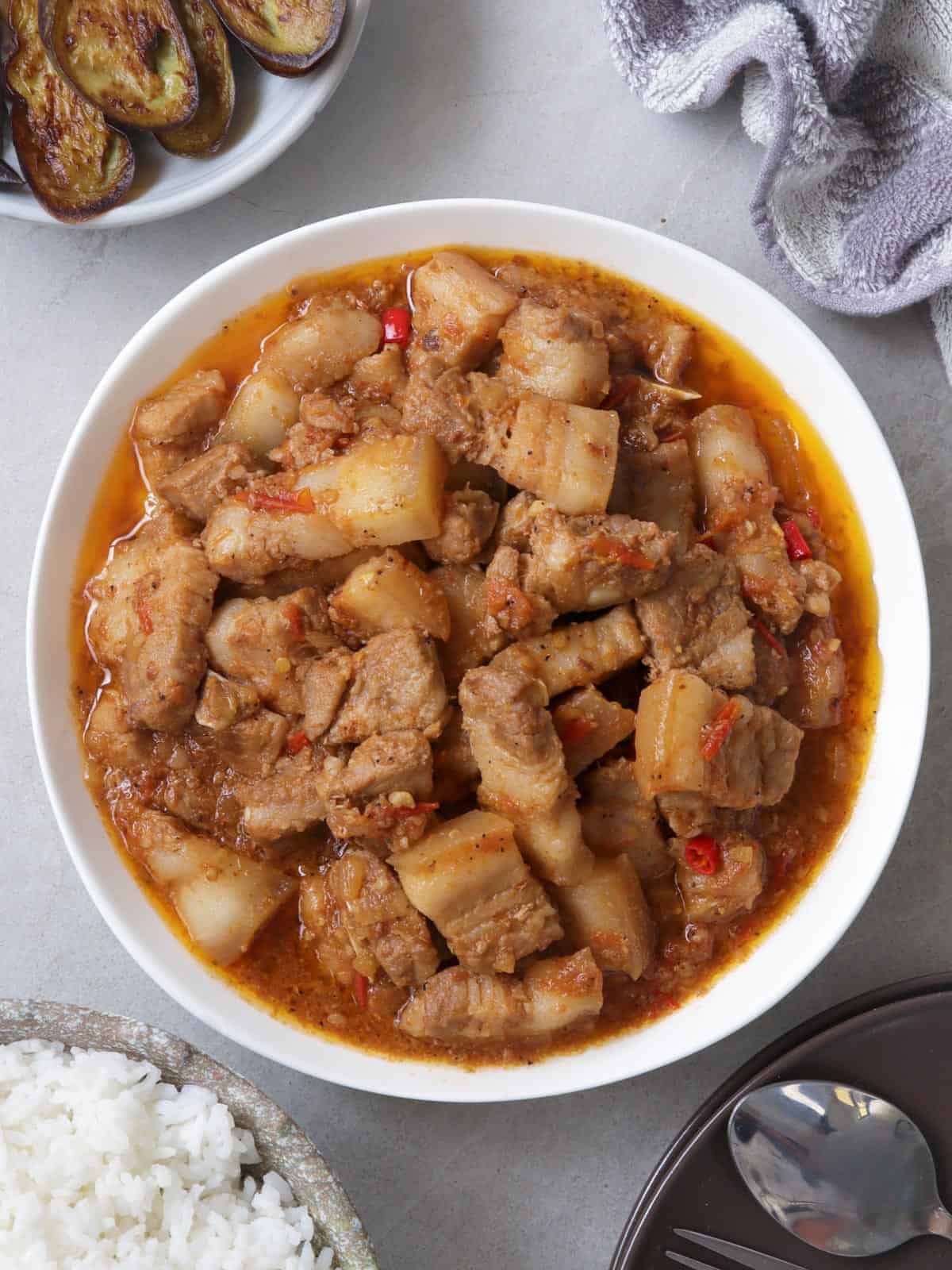
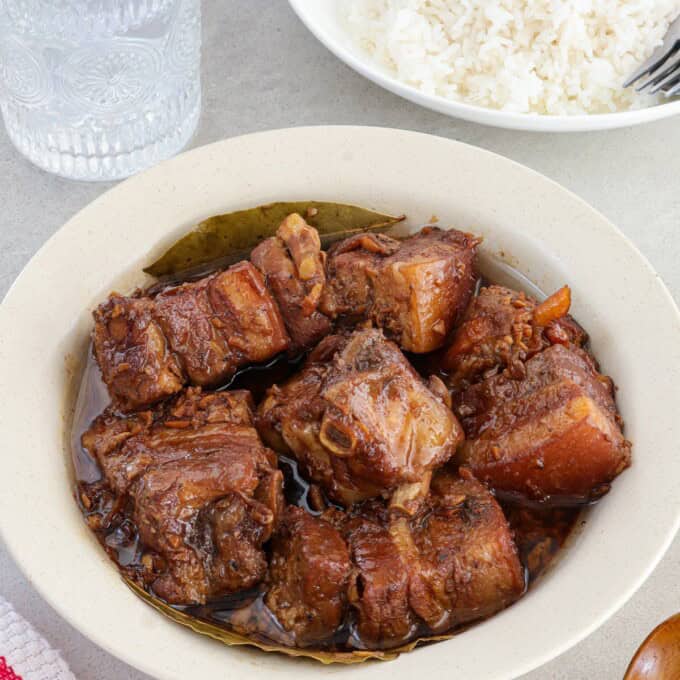
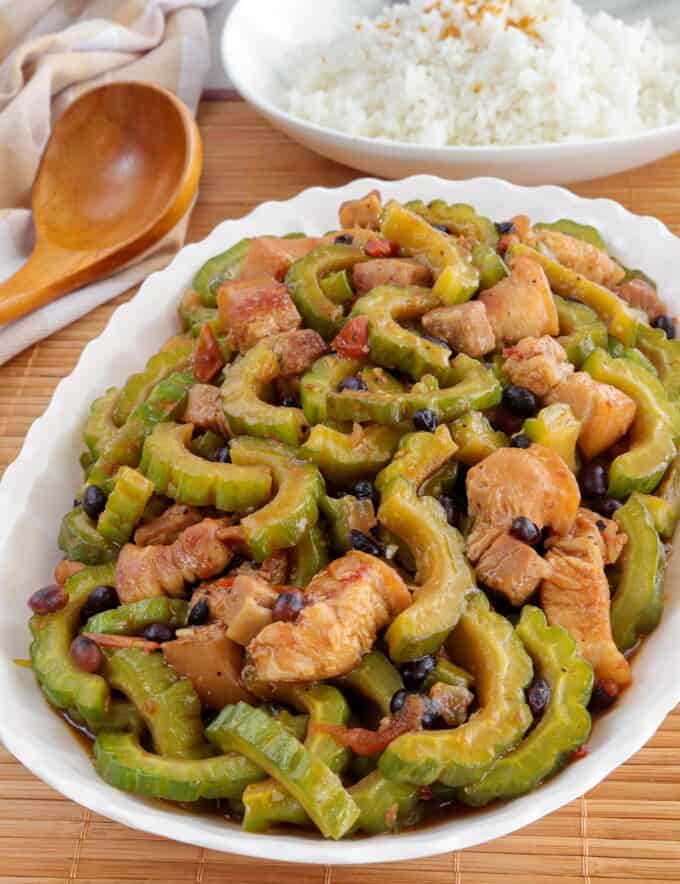
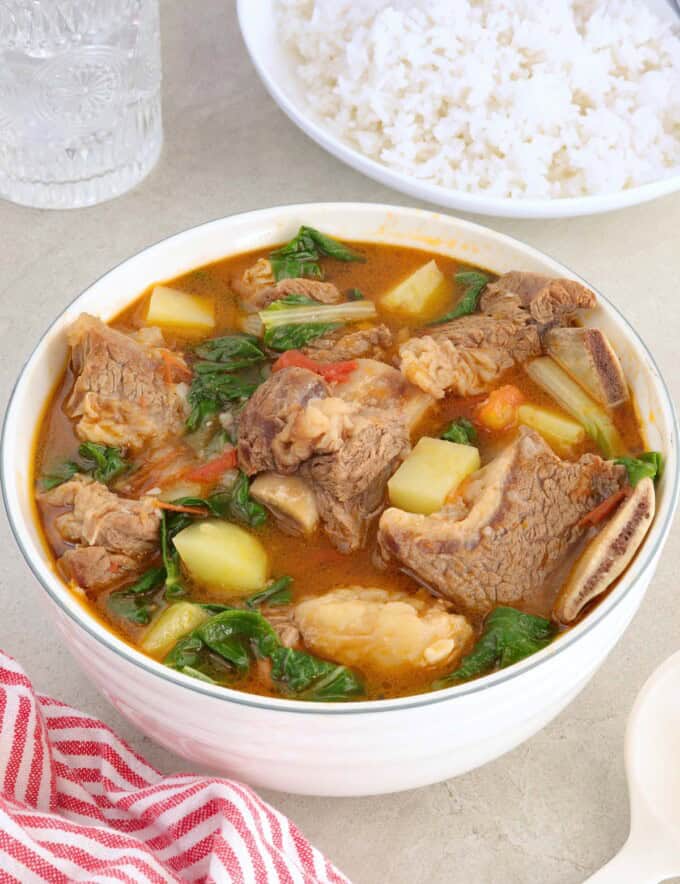
Sheldon Fujiwara says
This recipe was awesome!!! The taste was sooo amazing! Thank you for sharing!
Lalaine Manalo says
Thank you so much!
Sheena says
Legitimately, too much vinegar even with the right portions of meat and brand. Lessen your vinegar to soy sauce and water mix to balance the reaction/taste. Otherwise, you’re all set.
RODEL says
THE COOK IS VERY NICE IT WELL DEESERVE IT ALL THE MOMS CAN COOK THIS BECUASE IT SO AMAZE FOR ME
Nicole says
Way too much vinegar in this recipe!
Lalaine Manalo says
The amount of vinegar is just right for the amount of pork called for. Please allow the vinegar to boil uncovered and without stirring to cook off the strong acid taste.
Diane says
I made this last night. First time I cooked a REAL adobo!! 🙂 I love this recipe. Thank yo!!
Lalaine Manalo says
Thanks for the 5-stars! I'm glad you enjoyed it.
Ajo says
How many grams per serving?
Jenny says
Making this right now and looking forward to tasting it! A couple of questions: What is the reason behind allowing the vinegar to boil without stirring? Does stirring affect the flavor somehow? Also, have you ever tried it with different vinegars?
Lalaine Manalo says
It's to cook off the strong acid taste. I'm not sure what chemical interaction happens but the "sour" flavor seems to be more intense when the vinegar is stirred during the first few minutes of cook time. I've used other types of vinegar such as distilled or pple cider when I run out of the Filipino brand. I do prefer to use Datu Puti.
Teahi Ah Quin says
Question: in the ingredients there is 1 Cup of water listed but I don’t see it used in the instructions. When do you add the water?
Art says
Thank you for the recipe! What brand of soy sauce do you use? Datu puti or something else?
Lalaine Manalo says
I use mostly Datu Puti 🙂
Milette says
I made this adobo with fried potatoes and hard boiled eggs. I also added 2 t of liver spread and tasted delicious also. Thx for sharing , love your recipes....
Lalaine Manalo says
Thanks for the feedback; I'm glad you were able to modify the recipe to fit your tastes. 🙂
Jade Low says
I am cooking it now, thank you for the recipe
Lalaine Manalo says
Enjoy!
Michael Stevenson says
Hi.
This is my favourite version of the dish. My wife and step daughters were born and raised in Siston Negros Oriental, and this is like the dish I have when we visit the family there.
In the UK I add small waxy potatoes and carrots but still cook down to a sticky sauce.
I also use lard not oil for the frying - this is belly pork so not a slimmers fat free meal - this is all about salty fatty taste!
Mike
Lalaine Manalo says
Thank you so much for the feedback! I love adding potatoes also; they're a delicious way to extend the dish and add a contrast of texture.
Michaela Mae Ampuan says
I made this today and it's really good! I made some adjustments though, since I only used 1/2 kg of pork. I also added a tablespoon of sugar and mirin. Thank you for sharing this recipe 🙂
Lalaine Manalo says
Thanks for the 5-stars! I am glad the recipe worked well for you. And yes, a touch of sweetness makes adobo extra yummy 🙂
P says
Hello can I use this with a crockpot? If so how would I make this with the vinegar?
Lalaine Manalo says
Yes, you can make this in the crockpot. Sear the meat first in a skillet and transfer to the crockpot. Add the rest of the ingredients and cook on low or high heat depending on how much time you have to wait. When the meat is just about tender, remove the cover and allow to simmer uncovered to take the edge of the vinegar.
Crystal says
I find it helpful to always specify which kind of vinegar you use. "White vinegar" or "vinegar" is not a good description because in the US, vinegar is always apple vinegar (either white or cider), and it makes very bad adobo for many reasons. It took me years and a few trips to the Philippines to realize coconut vinegar is also white. Now that I know, I get coconut vinegar. Thanks!
Lalaine Manalo says
Thanks for the tip! Yes, I should specify I use as different brands of vinegar and even soy sauce has different tastes.
Camille Patio says
Thanks for this superb taste! I cooked it tonight! Tweaked a lil bit add 2 more tbsp of soysauce and 2 tsp of brown sugar!
Lalaine Manalo says
You're welcome. Glad you were able to adjust the recipe to your liking!